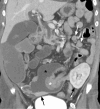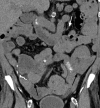Case Report: Metastatic small bowel adenocarcinoma with DNA mismatch repair deficiency in an organ transplant recipient treated with anti-PD-1 immunotherapy
- PMID: 40575172
- PMCID: PMC12197958
- DOI: 10.3389/fonc.2025.1579364
Case Report: Metastatic small bowel adenocarcinoma with DNA mismatch repair deficiency in an organ transplant recipient treated with anti-PD-1 immunotherapy
Abstract
We present a case of a 65-year-old woman with a history of kidney and pancreas transplants for type 1 diabetes mellitus who presented with small bowel obstruction and was found to have a poorly differentiated small bowel adenocarcinoma with multifocal osseous and nodal metastases. Plasma-based next generation circulating tumor deoxyribonucleic acid (DNA) sequencing revealed mismatch repair deficiency and an exceptionally high tumor mutational burden (TMB) of 1069 mutations/megabase (mut/Mb). Initial management consisted of cytotoxic chemotherapy (FOLFOX; 5-fluorouracil, leucovorin, and oxaliplatin) given the urgent need for a clinical response. Following multidisciplinary discussion and shared decision-making, nivolumab was added with cycle 3 of FOLFOX. Transplant-related immunosuppression was adjusted, and pancreas and kidney transplant function were monitored closely. Potential organ rejection was monitored using donor-derived cell-free DNA. Immune-related adverse events were not observed. After 5 cycles of treatment (3 cycles involving nivolumab), she achieved a complete clinical, molecular, and radiographic response. There was minimal evidence of allograft rejection without signs of dysfunction. Treatment was discontinued and subsequent surveillance imaging suggested durable remission for at least 9 months following treatment cessation. This case highlights the importance of genomic testing and targeting actionable molecular alterations in patients with rare cancers, as well as the role of multidisciplinary care.
Keywords: DNA mismatch repair; allograft transplant; gastrointestinal cancer; immunotherapy; tumor mutational burden.
Copyright © 2025 Phung, Tsai, Park, Schat, Spong, Tsai, Kulkarni, Antonarakis and Gupta.
Conflict of interest statement
EA reports grants and personal fees from Janssen, Sanofi, Bayer, Bristol Myers Squibb, Curium, MacroGenics, Merck, Pfizer, AstraZeneca, and Clovis; personal fees from Aadi Bioscience, Aikido Pharma, Astellas, Amgen, Blue Earth, Corcept Therapeutics, Exact Sciences, Hookipa Pharma, In-vitae, Eli Lilly, Foundation Medicine, Menarini-Silicon Biosystems, Tango Therapeutics, Tempus and Z-alpha; grants from Novartis, Celgene, and Orion; and has a patent for an AR-V7 biomarker technology that has been licensed to Qiagen. LT is an employee and shareholder of Guardant Health. The remaining authors declare that the research was conducted in the absence of any commercial or financial relationships that could be construed as a potential conflict of interest.
Figures




Similar articles
-
Nivolumab for adults with Hodgkin's lymphoma (a rapid review using the software RobotReviewer).Cochrane Database Syst Rev. 2018 Jul 12;7(7):CD012556. doi: 10.1002/14651858.CD012556.pub2. Cochrane Database Syst Rev. 2018. PMID: 30001476 Free PMC article.
-
Polyclonal and monoclonal antibodies for treating acute rejection episodes in kidney transplant recipients.Cochrane Database Syst Rev. 2017 Jul 20;7(7):CD004756. doi: 10.1002/14651858.CD004756.pub4. Cochrane Database Syst Rev. 2017. PMID: 28731207 Free PMC article.
-
A rapid and systematic review of the clinical effectiveness and cost-effectiveness of paclitaxel, docetaxel, gemcitabine and vinorelbine in non-small-cell lung cancer.Health Technol Assess. 2001;5(32):1-195. doi: 10.3310/hta5320. Health Technol Assess. 2001. PMID: 12065068
-
Synbiotics, prebiotics and probiotics for solid organ transplant recipients.Cochrane Database Syst Rev. 2022 Sep 20;9(9):CD014804. doi: 10.1002/14651858.CD014804.pub2. Cochrane Database Syst Rev. 2022. PMID: 36126902 Free PMC article.
-
Does Augmenting Irradiated Autografts With Free Vascularized Fibula Graft in Patients With Bone Loss From a Malignant Tumor Achieve Union, Function, and Complication Rate Comparably to Patients Without Bone Loss and Augmentation When Reconstructing Intercalary Resections in the Lower Extremity?Clin Orthop Relat Res. 2025 Jun 26. doi: 10.1097/CORR.0000000000003599. Online ahead of print. Clin Orthop Relat Res. 2025. PMID: 40569278
References
Publication types
LinkOut - more resources
Full Text Sources
Miscellaneous

